Episodes
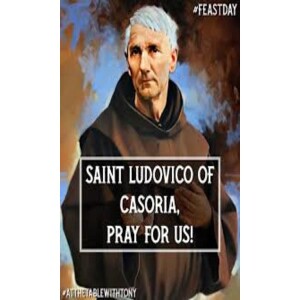
Friday Mar 29, 2024
Friday Mar 29, 2024
Stand In The Gap With Us And saint ludovico of casoria 3/29/2024
In 1847, he had a mystical experience which he later described as a cleansing. After that, he dedicated his life to the poor and the infirm, establishing a dispensary for the poor, two schools for African children, an institute for the children of nobility, as well as an institution for orphans, the deaf, and the speechless, and other institutes for the blind, elderly, and for travelers. In addition to an infirmary for friars of his province, he began charitable institutes in Naples, Florence, and Assisi. He once said, “Christ’s love has wounded my heart.” This love prompted him to great acts of charity.
To help continue these works of mercy, in 1859 he established the Gray Brothers, a religious community composed of men who formerly belonged to the Secular Franciscan Order. Three years later, he founded the Gray Sisters of St. Elizabeth for the same purpose.
Toward the beginning of his final, nine-year illness, Ludovico wrote a spiritual testament which described faith as “light in the darkness, help in sickness, blessing in tribulations, paradise in the crucifixion, and life amid death.” The local work for his beatification began within five months of Ludovico’s death. He was beatified in 1993 and canonized in 2014.
Pope John Paul IIbeatified him on 18 April 1993 and Pope Francis canonized him on 23 November 2014

Thursday Mar 28, 2024
Thursday Mar 28, 2024
Stand In The Gap With Us And Saint Catherine of Bologna 3/28/2024
Born in Bologna, Catharine was related to the nobility in Ferrara, and was educated at court there. She received a liberal education at the court and developed some interest and talent in painting. In later years as a Poor Clare, Catharine sometimes did manuscript illumination and also painted miniatures.
At the age of 17, she joined a group of religious women in Ferrara. Four years later, the whole group joined the Poor Clares in that city. Jobs as convent baker and portress preceded her selection as novice mistress.
In 1456, she and 15 other sisters were sent to establish a Poor Clare monastery in Florence. As abbess, Catharine worked to preserve the peace of the new community. Her reputation for holiness drew many young women to the Poor Clare life. She was canonized in 1712. The liturgical feast of Saint Catharine of Bologna is celebrated on May 9.
Saint Catherine feast day was on March 9 and was canonized on May 22 1712 by Pope Clement XL. She is the patron saint of Art , against temptations, artists, Bologna Academy of Art, Liberal arts and Painters. Saint Catherine's symbol was a palette and paint brushes, because she was an artist/painter.
She was a model of piety and reported experiencing miracles and several visions of Christ, the Virgin Mary,
She soon began to experience visions of Christ and Satan, and wrote of her experiences, one of which occurred one Christmas.
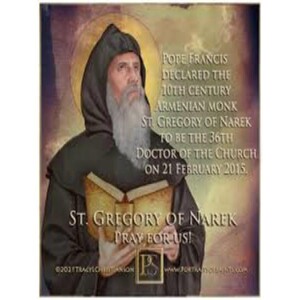
Wednesday Mar 27, 2024
Wednesday Mar 27, 2024
Stand In The Gap With Us And Saint Gregory of Narek 3/27/2024
Gregory was born in a village on the shores of Lake Van between 945 and 950. When his parents died, Gregor and his older brother were raised by a scholarly uncle who had them educated at the Narek monastery where he was a monk. The monastery was a prominent center of learning located in what is now Turkey. Gregor too entered the monastery and was ordained in 977.
A professor of theology, Gregor wrote a mystical interpretation of the Song of Songs, and a long mystical poem called the Book of Prayer or the Book of Lamentations. He described his poem as “an encyclopedia of prayer for all nations.” This classic of Armenian literature has been translated into 30 languages. The Russian text of the Book of Lamentations was set to music in 1985.
Little else is known about Gregor, other than he died in the early 11th century and was buried within the walls of the Narek monastery where he had spent his life. In 2015 as the world observed the 100th anniversary of the Armenian genocide in the Ottoman Empire, Pope Francis concelebrated a Mass at the Vatican with Patriarch Nerses Bedros XIX Tarmouni and declared the monk, poet, and saint of the Armenian Apostolic Church, Gregory of Narek, a Doctor of the Church. His liturgical feast is celebrated on February 27.
As opposed to the Armenian Catholic Church that began in the 17th century, the earlier Armenian Apostolic Church did not accept the Council of Chalcedon’s 451 teaching that Christ was fully divine and fully human. In 1996, St. John Paul II and Apostolic Catholicos Karekin I signed a declaration confirming the common faith of their two Churches. Prayer often unites groups of people who have seen themselves as very distinct—even enemies.
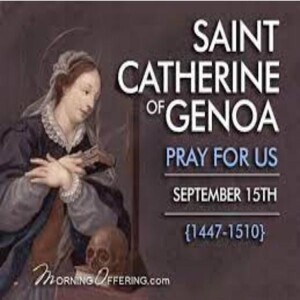
Tuesday Mar 26, 2024
Tuesday Mar 26, 2024
Stand In The Gap With Us And Saint Catherine of Genoa 3/26/2024 Going to confession one day was the turning point of Catherine’s life.
St. Catherine of Genoa is a saint who helped to shape the Catholic reformation through a hidden life of prayer and abandonment to God. Her sufferings as a young bride influenced her later life of prayer and work, and she is best known for her writings on the love of God and Purgatory.
When Catherine was born, many Italian nobles were supporting Renaissance artists and writers. The needs of the poor and the sick were often overshadowed by a hunger for luxury and self-indulgence. Catherine’s parents were members of the nobility in Genoa. At 13, she attempted to become a nun but failed because of her age. At 16, she married Julian, a nobleman who turned out to be selfish and unfaithful. For a while she tried to numb her disappointment by a life of selfish pleasure.
St. Catherine of Siena was a Dominican tertiary and mystic who lived in Italy in the 1300s. She was known for her holiness, asceticism, and spiritual visions and was said to have received stigmata. She was also a reformer and political activist, and she was influential in religious and political affairs of the church.
One day in confession she had a new sense of her own sins and how much God loved her. She reformed her life and gave good example to Julian, who soon turned from his self-centered life of distraction. Julian’s spending, however, had ruined them financially.
“Lord, I make you a present of myself I do not know what to do with myself. Let me, then, Lord, make this exchange: I will place this evil being into your hands.ou are the only one who can hide it in your goodness and can so rule over me that nothing will be seen of my own proper self.
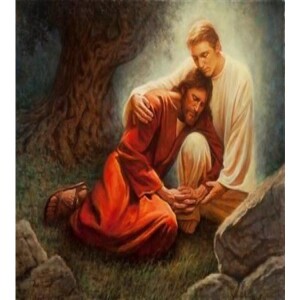
Tuesday Mar 26, 2024
Tuesday Mar 26, 2024
Christ the Miracle Worker in the EucharistDuring His visible stay on earth Christ performed countless miracles. He restored sight to the blind, hearing to the deaf and the use of their limbs to the paralyzed. The winds and sea obeyed Him. He told the dead Lazarus to come forth, and Lazarus came out of the grave. The crowning miracle of Christ's visible stay on earth was to raise Himself by His own divine power on Easter Sunday.
But Christ continues performing miracles in our day. I know of no single statement I can share with you that is more practically important than to be convinced that Christ works and wants to perform miracles in our favor today. And that we can add, for the best of reasons, because Jesus Christ is still on earth. And He promised, "Behold, I am with you all days even to the end of the world."
As we examine the Gospel narratives we find two remarkable facts. First, Jesus regularly associated His teaching with working with what John calls "signs and wonders". These signs and wonders made His humanly incomprehensible teaching believable. Miracles are necessary to make God's revelation credible. Please do not forget that. That statement is an article of the Catholic Faith.
Secondly - Christ during His visible stay on earth worked these miracles of course as God, but always through His humanity. In other words, the miracles performed by Jesus in Palestine were always the result of human words spoken, or the result of the touch of Christ's human hands. On one dramatic occasion a women was suddenly healed of years of hemorrhaging the moment she tugged on Christ's garments.
Jesus therefore performed (past tense) astounding wonders related in the Gospels. Always by His divine omnipotence but, (watch the preposition) but through His human nature as man. We are also told that on occasion that Jesus could not (this is the Almighty) perform miracles in certain places.
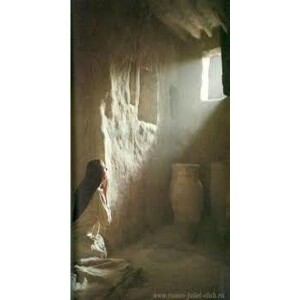
Monday Mar 25, 2024
Monday Mar 25, 2024
Stand In The Gap With Us As We Honor the Annunciation of The Lord 3/25/2024
"In the sixth month, the angel Gabriel was sent from God to a town of Galilee called Nazareth, to a virgin betrothed to a man named Joseph, of the house of David, and the virgin’s name was Mary. And coming to her, he said,
“Hail, Full of Grace! The Lord is with you.” But she was greatly troubled at what was said and pondered what sort of greeting this might be. Then the angel said to her, “Do not be afraid, Mary, for you have found favor with God. Behold, you will conceive in your womb and bear a son, and you shall name him Jesus. He will be great and will be called Son of the Most High, and the Lord God will give him the throne of David his father, and he will rule over the house of Jacob forever, and of his kingdom there will be no end.” But Mary said to the angel, “How can this be, since I have no relations with a man?” And the angel said to her in reply,
“The holy Spirit will come upon you, and the power of the Most High will overshadow you. Therefore the child to be born will be called holy, the Son of God. And behold, Elizabeth, your relative, has also conceived a son in her old age, and this is the sixth month for her who was called barren; for nothing will be impossible for God.” Mary said, “Behold, I am the handmaid of the Lord. May it be done to me according to your word.” Then the angel departed from her." Luke 1:26-38

Monday Mar 25, 2024
Monday Mar 25, 2024
Join John Carpenter, Don Hartley, and the Deeper Truth research team as they investigate another amazing appearance by our Blessed Mother in China.
In 1900, 10,000 troops of the Chinese anti-foreign, anti-Christian Boxer movement threatened to annihilate the inhabitants of the humble village of Dong Lu in China’s Hebei province. Dong Lu was a poor place, called the village of beggars. It consisted of a small community of Catholics. As the Boxers approached, the village priest Father Wu prayed to the Blessed Mother to intercede on behalf of the village. Our Lady, dressed in white, appeared in the sky with a fiery horseman believed to be St. Michael. The Boxers shot at the image, but it remained intact. Terrified, the Boxers fled, sparing the village.
In thanksgiving, Father Wu commissioned an artist to paint an image of the Madonna dressed in the royal robes of a Chinese dowager empress with a Christ Child on her knee. The image became known as Our Lady of Dong Lu, commemorating the victory over the Boxer assault. The regal appearance of Mary was meant to convey her intercessory power and queenship.
Our Lady of Dong Lu could be considered the Chinese version of Our Lady of Guadalupe. While not a miraculous portrait like that of the Mexican Blessed Mother, Our Lady of Dong Lu portrays Mary and the Christ Child as Chinese, reinforcing the undeniable truth that Catholicism is as much a part of China as it is in every other part of the world.
Through the decades, pilgrims have joined processions in Dong Lu led by the image of Our Lady of Dong Lu. In May 23, 1995, 30,000 Catholics had gathered for Mass celebrated by four underground bishops at the Dong Lu shrine. During the consecration, those gathered witnessed the sun spinning from left to right and the Lady of China and the Christ Child appearing in the sky. The next day, May 24, 100,000 worshipers arrived at the Dong Lu shrine,
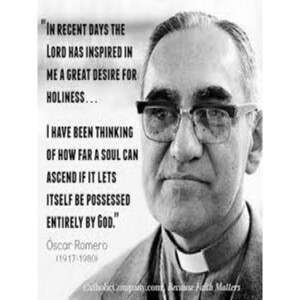
Sunday Mar 24, 2024
Sunday Mar 24, 2024
Stand In The Gap With Us And Saint Oscar Arnulfo Romero 3/24/2024
The night before he was murdered while celebrating Mass, Archbishop Oscar Romero of San Salvador said on the radio: “I would like to appeal in a special way to the men of the army, and in particular to the troops of the National Guard, the police, and the garrisons. Brothers, you belong to our own people. You kill your own brother peasants; and in the face of an order to kill that is given by a man, the law of God that says ‘Do not kill!’ should prevail.
“No soldier is obliged to obey an order counter to the law of God. No one has to comply with an immoral law. It is the time now that you recover your conscience and obey its dictates rather than the command of sin. . . . Therefore, in the name of God, and in the name of this long-suffering people, whose laments rise to heaven every day more tumultuous, I beseech you, I beg you, I command you! In the name of God: ‘Cease the repression!’”
Simultaneously, Romero had eloquently upheld the gospel and effectively signed his own death warrant.
When he was appointed archbishop of San Salvador in 1977, Bishop Romero was considered a very “safe” choice. He had served as auxiliary bishop there for four years before his three years as bishop of Santiago de Maria.
When a military junta seized control of the national government in 1979, Archbishop Romero publicly criticized the US government for backing the junta. His weekly radio sermons, broadcast throughout the country, were regarded by many as the most trustworthy source of news available.
Romero’s funeral was celebrated in the plaza outside the cathedral and drew an estimated 250,000 mourners.
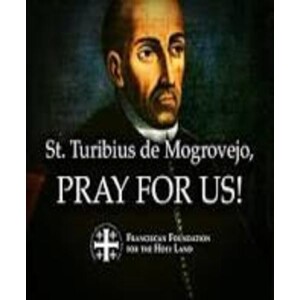
Sunday Mar 24, 2024
Sunday Mar 24, 2024
Stand In The Gap With Us And Saint Turibius of Mogrovejo 3/23/2024
Together with Rose of Lima, Turibius is the first known saint of the New World, serving the Lord in Peru, South America, for 26 years.
Catholics in Latin America and throughout the world will celebrate the life and ministry of St. Turibius of Mogrovejo on March 23. The 16th century bishop upheld the rights of Peru's indigenous peoples, and became one of the first canonized saints of the Americas.
Turibius was born in Spain during 1538, to a noble family in the kingdom of Leon. He frequently prayed, fasted, and gave to the poor even as a child, and eventually developed the daily habit of praying the Rosary along with the Little Office of the Blessed Virgin Mary.
To the indigenous Peruvians, the archbishop was a herald of the Gospel who held their lives as more precious than their country's supplies of gold and silver. But to the many colonists whose behavior showed no sign of their Catholic origins, he was a prophetic scourge – whose efforts to awaken the public conscience earned him rebukes and opposition.
Born in Spain and educated for the law, he became so brilliant a scholar that he was made professor of law at the University of Salamanca and eventually became chief judge of the Inquisition at Granada. He succeeded too well. But he was not sharp enough a lawyer to prevent a surprising sequence of events.
When the archdiocese of Lima in Peru required a new leader, Turibius was chosen to fill the post: He was the one person with the strength of character and holiness of spirit to heal the scandals that had infected that area.

Friday Mar 22, 2024
Friday Mar 22, 2024
Stand In The Gap With Us And Saint Nicholas Owen 3/22/2024
After a number of narrow escapes, he himself was finally caught in 1594. Despite protracted torture, Nicholas refused to disclose the names of other Catholics. After being released following the payment of a ransom, “Little John” went back to his work.
He was arrested again in 1606. This time he was subjected to horrible tortures, suffering an agonizing death. The jailers tried suggesting that he had confessed and committed suicide, but his heroism and sufferings soon were widely known.
Owen was of very short stature, and suffered from a hernia,[6] as well as a crippled leg from a horse falling on him. Nevertheless, his work often involved breaking through thick stonework, and to minimise the likelihood of betrayal, he often worked at night and always alone. Sometimes, he built an easily discovered outer hiding place, which concealed an inner hiding place.
The location of the secret room was known to only himself and the owner of the house. Examples of his work survive at Sawston Hall in Cambridgeshire, Oxburgh Hall in Norfolk,
